Cactus
-

Euphorbia ammak lagre cactus for sale
Euphorbia ammak ”Variegata’iCandelabra Spurge) is a striking evergreen succulent with a short trunk and uprighioranches in the shape of a branched candelabra. The entire surface is marbled with creamy-ye low and pale bluegreen. The ribs are thick, wavy, usua ly four-winged, with contrasting dark brown spines. Fast-growing,Candelabra Spurge should be given plenty of room to grow. Very architectural, this prickly, columnar succulenttree brings a ravishing silhouette to the desert or succulent garden.
Typically grows up to 15-20 ft. tall (4-6 m) and 6-8 ft. wide (2-3 m)
This remarkable plant is resilient to most pests and diseases, is deer or rabbit resistant, and is easy tocare for.
Performs best in full sun or light shade, in welldrained soils. Water regularly during the active growingseason,but keep almost completely dry in winter.
Perfect addition to beds and borders, Mediterranean Gardens.
Natiye to Yemen,Saudi Arabia peninsula.
All parts of the plant are highly toxic if ingested. The milky sap may cause irritation to the skin and eyes. Beyery careful when handling this plant as the stems break easily and the milky sap can burn the skin. Usegloves and protective goggles. -
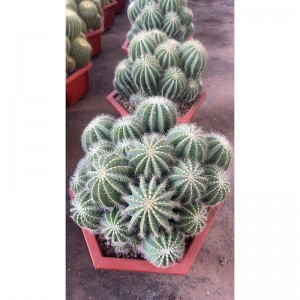
Yello cactus parodia schumanniana for sale
Parodia schumanniana is a perennial globular to columnar plant with a diameter of about 30 cm and a height up to 1.8 meters. The 21-48 well-marked ribs are straight and sharp. The bristle-like, straight to slightly curved spines are initially golden yellow, turning to brown or red and gray later. The one to three central spines, which can sometimes also be absent, are 1 to 3 inches long. The flowers bloom in Summer. They are lemon-yellow to golden yellow, with a diameter of about 4.5 to 6.5 cm. The fruits are spherical to ovoid, covered with dense wool and bristles and have diameters up to 1.5 centimeters. They contains reddish-brown to almost black seeds, which are nearly smooth and 1 to 1.2 millimeters long.
-
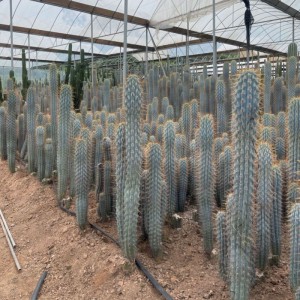
Browningia hertlingiana
Also known as “Blue cereus”. This cactacea plant, with a columnar habit, can reach up to 1 meter in height. The stem has rounded and slightly tuberculated ribs with sparse downy areoles, from which very long and rigid yellow spines protrude. Its strength is its turquoise blue color, rare in nature, which makes it highly sought after and appreciated by green collectors and cactus lovers. Flowering occurs in summer, only on the plants higher than one meter, blooming, at the apex, with large, white, nocturnal flowers, often with purplish brown shades.
Size: 50cm~350cm
-
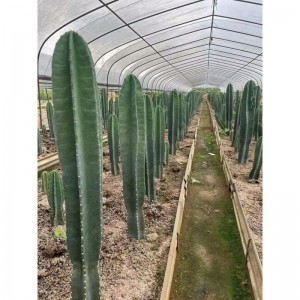
Selenicereus undatus
Selenicereus undatus, the white-fleshed pitahaya, is a species of the genus Selenicereus (formerly Hylocereus) in the family Cactaceae[1] and is the most cultivated species in the genus. It is used both as an ornamental vine and as a fruit crop – the pitahaya or dragon fruit.[3]
Like all true cacti, the genus originates in the Americas, but the precise native origin of the species S. undatus is uncertain and never been resolved it may be a hybrid
Size:100cm~350cm
-
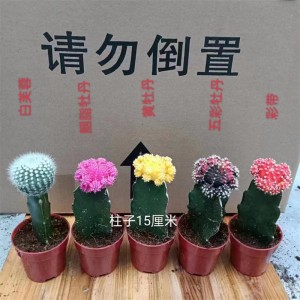
beautiful real plant moon cactus
Style: Perennial Type: Succulent Plants Size: Small Use: Outdoor Plants Color: multi-colors Feature: live plants -
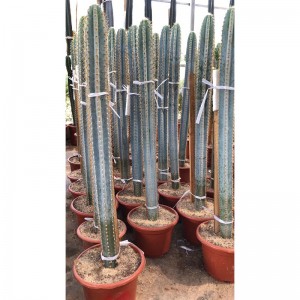
Edit blue columnar cactus Pilosocereus pachycladus
It is one of the most spectacular columnar tree-like cereus 1 to 10 (or more) m tall. It ramify at the base or develops a distinct trunk with dozens of erected glaucous (bluish-silver) branches. Its elegant habit (shape) makes it look like a miniature blue Saguaro. This is one of the bluest columnar cacti. Stem: Turquoise/ sky blue or light blue-green. Branches 5,5-11 cm in diameter. Ribs: 5-19 about, straight, with traverse folds visible only at the stem apexes, 15-35 mm wide and with12-24 m... -
-300x300.jpg)
Live Plant Cleistocactus Strausii
Cleistocactus strausii, the silver torch or wooly torch, is a perennial flowering plant in the family Cactaceae.
Its slender, erect, grey-green columns can reach a height of 3 m (9.8 ft), but are only about 6 cm (2.5 in) across. The columns are formed from around 25 ribs and are densely covered with areoles, supporting four yellow-brown spines up to 4 cm (1.5 in) long and 20 shorter white radials.
Cleistocactus strausii prefers mountainous regions that are dry and semi-arid. Like other cacti and succulents, it thrives in porous soil and full sun. While partial sunlight is the minimum requirement for survival, full sunlight for several hours a day is required for the silver torch cactus to bloom flowers. There are many varieties introduced and cultivated in China. -

Large Cactus Live Pachypodium lamerei
Pachypodium lamerei is a species of flowering plant in the family Apocynaceae.
Pachypodium lamerei has a tall, silvery-gray trunk covered with sharp 6.25 cm spines. Long, narrow leaves grow only at the top of the trunk, like a palm tree. It rarely branches. Plants grown outdoors will reach up to 6 m (20 ft), but when grown indoors it will slowly reach 1.2–1.8 m (3.9–5.9 ft) tall.
Plants grown outdoors develop large, white, fragrant flowers at the top of the plant. They rarely flower indoors.The stems of Pachypodium lamerei are covered in sharp spines, up to five centimetres long and grouped in threes, which emerge almost at right angles. The spines perform two functions, protecting the plant from grazers and helping with water capture. Pachypodium lamerei grows at elevations up to 1,200 metres, where sea fog from the Indian Ocean condenses on the spines and drips onto the roots at the surface of the soil. -
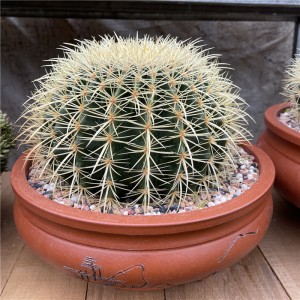
NurseryNature Cactus Echinocactus Grusonii
Category CactusTags cactus rare, echinocactus grusonii, golden barrel cactus echinocactus grusonii
golden barrel cactus sphere is round and green, with golden thorns, hard and powerful. It is a representative species of strong thorns. The potted plants can grow into large, regular specimen balls to decorate the halls and become more brilliant. They are the best among indoor potted plants.
Golden barrel cactus likes sunny, and more like fertile, sandy loam with good water permeability. During the high temperature and hot period in summer, the sphere should be properly shaded to prevent the sphere from being burned by the strong light. -
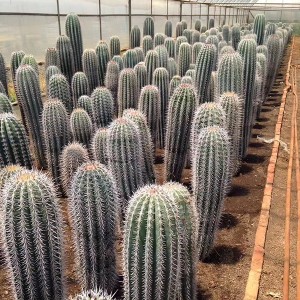
Nursery-live Mexican Giant Cardon
Pachycereus pringlei also known as Mexican giant cardon or elephant cactus
Morphology[edit]
A cardon specimen is the tallest[1] living cactus in the world, with a maximum recorded height of 19.2 m (63 ft 0 in), with a stout trunk up to 1 m (3 ft 3 in) in diameter bearing several erect branches. In overall appearance, it resembles the related saguaro (Carnegiea gigantea), but differs in being more heavily branched and having branching nearer the base of the stem, fewer ribs on the stems, blossoms located lower along the stem, differences in areoles and spination, and spinier fruit.
Its flowers are white, large, nocturnal, and appear along the ribs as opposed to only apices of the stems. -

tall cactus golden saguaro
The common names of Neobuxbaumia polylopha are the cone cactus, golden saguaro, golden spined saguaro, and wax cactus. The form of Neobuxbaumia polylopha is a single large arborescent stalk. It can grow to heights of over 15 meters and can grow to weigh many tons. The pith of the cactus can be as wide as 20 centimeters. The columnar stem of the cactus has between 10 and 30 ribs, with 4 to 8 spines arranged in a radial manner. The spines are between 1 and 2 centimeters in length and are bristle like. The flowers of Neobuxbaumia polylopha are a deeply tinted red, a rarity among columnar cacti, which usually have white flowers. The flowers grow on most of the areoles. The areoles that produce flowers and the other vegetative areoles on the cactus are similar.
They are used to create groups in the garden, as isolated specimens, in rockeries and in large pots for terraces. They are ideal for coastal gardens with a Mediterranean climate.






-300x300.jpg)



